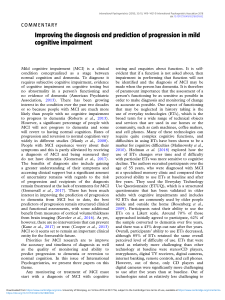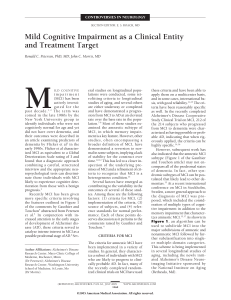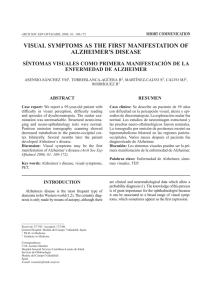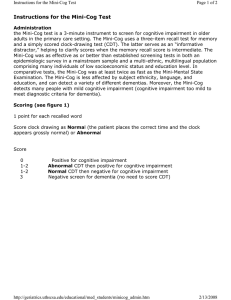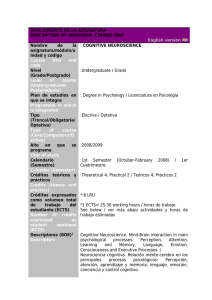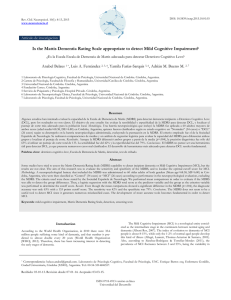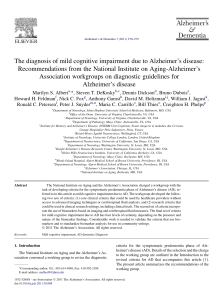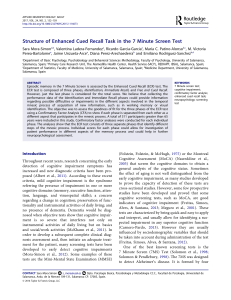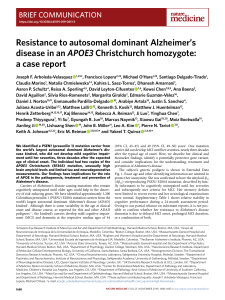Inglés - SciELO España
Anuncio
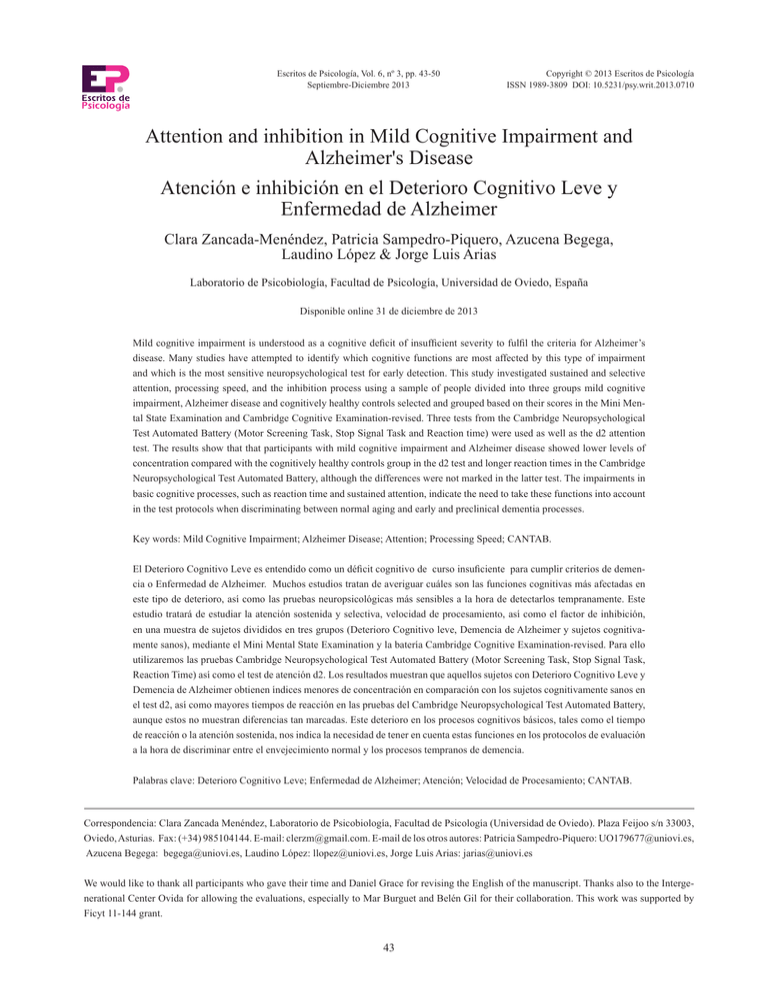
Escritos de Psicología, Vol. 6, nº 3, pp. 43-50 Septiembre-Diciembre 2013 Copyright © 2013 Escritos de Psicología ISSN 1989-3809 DOI: 10.5231/psy.writ.2013.0710 Attention and inhibition in Mild Cognitive Impairment and Alzheimer's Disease Atención e inhibición en el Deterioro Cognitivo Leve y Enfermedad de Alzheimer Clara Zancada-Menéndez, Patricia Sampedro-Piquero, Azucena Begega, Laudino López & Jorge Luis Arias Laboratorio de Psicobiología, Facultad de Psicología, Universidad de Oviedo, España Disponible online 31 de diciembre de 2013 Mild cognitive impairment is understood as a cognitive deficit of insufficient severity to fulfil the criteria for Alzheimer’s disease. Many studies have attempted to identify which cognitive functions are most affected by this type of impairment and which is the most sensitive neuropsychological test for early detection. This study investigated sustained and selective attention, processing speed, and the inhibition process using a sample of people divided into three groups mild cognitive impairment, Alzheimer disease and cognitively healthy controls selected and grouped based on their scores in the Mini Mental State Examination and Cambridge Cognitive Examination-revised. Three tests from the Cambridge Neuropsychological Test Automated Battery (Motor Screening Task, Stop Signal Task and Reaction time) were used as well as the d2 attention test. The results show that that participants with mild cognitive impairment and Alzheimer disease showed lower levels of concentration compared with the cognitively healthy controls group in the d2 test and longer reaction times in the Cambridge Neuropsychological Test Automated Battery, although the differences were not marked in the latter test. The impairments in basic cognitive processes, such as reaction time and sustained attention, indicate the need to take these functions into account in the test protocols when discriminating between normal aging and early and preclinical dementia processes. Key words: Mild Cognitive Impairment; Alzheimer Disease; Attention; Processing Speed; CANTAB. El Deterioro Cognitivo Leve es entendido como un déficit cognitivo de curso insuficiente para cumplir criterios de demencia o Enfermedad de Alzheimer. Muchos estudios tratan de averiguar cuáles son las funciones cognitivas más afectadas en este tipo de deterioro, así como las pruebas neuropsicológicas más sensibles a la hora de detectarlos tempranamente. Este estudio tratará de estudiar la atención sostenida y selectiva, velocidad de procesamiento, así como el factor de inhibición, en una muestra de sujetos divididos en tres grupos (Deterioro Cognitivo leve, Demencia de Alzheimer y sujetos cognitivamente sanos), mediante el Mini Mental State Examination y la batería Cambridge Cognitive Examination-revised. Para ello utilizaremos las pruebas Cambridge Neuropsychological Test Automated Battery (Motor Screening Task, Stop Signal Task, Reaction Time) así como el test de atención d2. Los resultados muestran que aquellos sujetos con Deterioro Cognitivo Leve y Demencia de Alzheimer obtienen índices menores de concentración en comparación con los sujetos cognitivamente sanos en el test d2, así como mayores tiempos de reacción en las pruebas del Cambridge Neuropsychological Test Automated Battery, aunque estos no muestran diferencias tan marcadas. Este deterioro en los procesos cognitivos básicos, tales como el tiempo de reacción o la atención sostenida, nos indica la necesidad de tener en cuenta estas funciones en los protocolos de evaluación a la hora de discriminar entre el envejecimiento normal y los procesos tempranos de demencia. Palabras clave: Deterioro Cognitivo Leve; Enfermedad de Alzheimer; Atención; Velocidad de Procesamiento; CANTAB. Correspondencia: Clara Zancada Menéndez, Laboratorio de Psicobiología, Facultad de Psicología (Universidad de Oviedo). Plaza Feijoo s/n 33003, Oviedo, Asturias. Fax: (+34) 985104144. E-mail: [email protected]. E-mail de los otros autores: Patricia Sampedro-Piquero: [email protected], Azucena Begega: [email protected], Laudino López: [email protected], Jorge Luis Arias: [email protected] We would like to thank all participants who gave their time and Daniel Grace for revising the English of the manuscript. Thanks also to the Intergenerational Center Ovida for allowing the evaluations, especially to Mar Burguet and Belén Gil for their collaboration. This work was supported by Ficyt 11-144 grant. 43 CLARA ZANCADA-MENÉNDEZ, PATRICIA SAMPEDRO-PIQUERO, AZUCENA BEGEGA, LAUDINO LÓPEZ, JORGE LUIS ARIAS The term Mild Cognitive Impairment (MCI) has been considered by the National Institute on Aging and the Alzheimer’s Association as an impairment that is characterized by deficits in one or more cognitive functions, preservation of independence in functional abilities and absent of dementia (McKhann et al., 2011). Nowadays many researchers are focusing on MCI as an area of study, since it has been estimated that the annual conversion rate of MCI patients to Alzheimer’s disease (AD) is 10-15%, and that this figure could increase up to 50% within three years (Fischer et al., 2007). Furthermore, epidemiology studies reflect that the global prevalence of dementia represents about 24 million people and it has been predicted that this population will double every 20 years until at least 2040 (Mayeux & Stern, 2012). Therefore, reliable and sensitive assessments, which permit a rapid detection of MCI and AD, are essential. We must also take into account that AD could become a serious problem, generating a high state of dependence of subjects, which results in a high psychological, social, and economic cost. This has made us to consider the need to discover what other basic cognitive functions may be affected in MCI, and if they can assist in making a more reliable and efficient evaluation of this disorder, to prevent in as far as is possible the conversion to AD. Many classifications of MCI over the years have tried to facilitate clinical diagnosis (Dubois et al., 2010). One of the most widely accepted classifications by the scientific community was proposed by Petersen et al. (2009) that differentiates four types of MCI: amnestic, multidomain amnestic (altering other functions besides memory), non-amnestic (altering one function that is not memory), and non-amnestic multidomain (altering more than one function that is not memory). Cognitive impairment can therefore occur in several cognitive domains and this led us to hypothesize that perhaps the subjects with MCI deficits in complex cognitive functions like memory, are partly explained by changes in other basic functions such as processing speed, attention or the existence of interference information phenomena. Salthouse (1996) explains that the processing speed may be significantly affecting the other cognitive processes, which in turn can lead to a less effective encoding of the stimuli. On the other hand, the core clinical criteria of AD is characterized by an insidious onset, clear cut history of worsening by report or observation, the cognitive deficits in both amnestic and non-amnestic presentation. Finally, this diagnosis should not be applied when there is evidence of a substantial concomitant cerebrovascular disease, dementia with Lewy bodies, frontotemporal dementia, and prominent features of semantic variant primary progressive aphasia or use of medication that could have a substantial effect on cognition (McKhann et al., 2011). With regard to the attention process, authors such as Perry & Hodges (1999), have already highlight the role of attention in AD, indicating the importance of differentiating both quan- titatively and qualitatively attentional dysfunctions produced in AD. These authors believed this process could be closely related to the deterioration process of this disease. Attention is understood as the set of processes enabling and guiding the selection of incoming perceptual information (Roda & Thomas, 2006). We can differentiate between selective, sustained and divided attention. Selective attention refers to the processes that allow selecting and focus on a particular input for further processing, whereas simultaneously suppressing irrelevant or distracting information (Stevens & Bavelier, 2011). Several studies have examined whether selective attention is impaired in the early stages of AD (Fernandez-Duque & Black, 2006). Greater problems with selective attention have also been seen in the presence of distracting stimuli (McDowd & Birren, 1990). Through the use of the shift test “set intradimensional and extradimensional” CANTAB battery, in which subjects must shift selective attention between two-dimensional figures (shape, colour), it was observed that this function is altered in preclinical stages of AD (Dorion et al., 2002), and that even this poor performance is a good predictor of the progression of these patients (Albert, Moss, Tanzi & Jones, 2001). Sustained attention refers to when the subject starts attentional mechanisms for relatively long periods of time (Parasuraman, 1984). In cases of early stages of MCI or AD, some works concluded that sustained attention would be the least affected (Gainotti, Marra & Villa, 2001). Estévez-González et al. (2003) found that in a sustained attention task, those subjects who within two years developed AD, showed slower reaction times (RT) than patients whose cognitive functioning did not worsen. Therefore, there seems to be a deterioration in the performance of most attentional tasks with age and much more in subjects with cognitive impairment, but what is not yet clear is how and why this attention deficit occurs and if it may be a consequence of a generalized slowing process due to aging (García, 1997). Finally, another phenomenon common to aging is the interference of response or information. A study by Wylie, Ridderinkhof, Eckerle & Manning (2007) using a reaction time task, found that in both groups reaction times were longer when the distracters indicated an inconsistent response, in particular in subjects with MCI. Thus, the results suggest deficits in inhibition response in patients with MCI. Another question is to determine whether the interference comes from greater activation to the distracters, inefficient inhibition, or both processes. The motivation of this study was to determine if attentional and inhibitory processes allow discrimination between the groups of HC with MCI and MCI with AD. Since one of the key factors in the evaluation of these subjects is time, we wanted to introduce tests that would allow a quick assessment of the subject. On the other hand, we study the attentional and inhibition processes as we consider them very relevant for other cognitive functions impaired in neurodegenerative disease. We believe that both processes can be a useful tool in making an 44 ASSESSMENT OF ATTENTION AND INHIBITION PROCESSES early diagnosis, which could result in large benefits for the patient, due to the fact that activities and preventive treatments can be developed. Thus, the aim of this study is to examine if attention tests (d2 attention test (Brickenkamp, 1962) and response inhibition tests (CANTAB battery: Motor Screening, MOT; Stop Signal Task, SST and Reaction Time, RTI) are able to discriminate MCI against AD or cognitively healthy aging. Certain deficits in these basic cognitive functions would be expected in MCI patients, but not so severely as in AD. protection of personal data and bioethics. All participants were informed about the aims of the research, questionnaires and the confidentiality of their personal data and declared informed consent. The evaluation was divided into two sessions. First we began with a structured interview and then sections B and C of the CAMDEX test were administered for the correct categorization of the subjects in three groups (HC, MCI, AD). In the second session, the d2 attention test (Brickenkamp, 1962) was administered. In order to avoid that the poor vision would impair the performance in this test, the size of the characters were adapted to a larger size (29.5 x 42 cm.). Also, in this second session, three tests of the Cambridge Neuropsychological Test Automated Battery (CANTAB) (Motor Screening Task (MOT), Stop Signal Task (SST), Reaction Time (RTI)) were administered. Method Participants There were 36 participants, 29 females and 7 males, from the Intergeneracional Ovida Center (Oviedo, Asturias) with ages ranging from 66 to 96 years (M= 81.25, SD= 6.49). Regarding the educational level, 4 of the subjects do not have studies, 15 have primary education, 12 have high school education, and finally 5 have university studies. The groups were homogeneous in age (MMCI = 80, MAD = 84, MHC = 79 years) and educational level, measured by years of schooling (MMCI = 14, MAD = 16, MHC = 14). Although at present the utility of the Mini Mental State Examination (MMSE) is debated and some studies do not recommend it as a screening or diagnostic instrument (Tierney, Szalai, Dunn, Geslani & McDowell, 2000) others support its use as a general screening test, (Mora-Simon et al., 2012; Fujisawa et al., 2013). In our case, we decided to use it as the latter, using it only for our inclusion criteria, being equal to or higher than 27 for healthy subjects, for the rest of the groups <27, and to be over 65 years of age. In turn, we excluded patients with cerebrovascular disease, non-Alzheimer dementia and mental disorders. AD has been documented in the evidence of progressive cognitive decline as well as in the evaluations with cognitive testing. Although, we decided to introduce the MMSE (Folstein, Folstein & McHugh, 1975) to form an initial classification, we used the CAMDEX-R in order to make a more reliable classification of subjects. Thereby the participants were classified into three groups, based on their total score in the CAMCOG test (extracted from CAMDEX-R, The Cambridge Examination for Mental Disorders of the Elderly-revised, Roth, Huppert, Tym & Mountjoy, 1998). To form the groups, cut-off points were chosen from the manual itself. Thus, below 69/70 score (n=10) were considered AD, between 71/89 MCI (n=13) and in a range of 90/105 (n =13) HC (Roth et al., 1998). Measures CAMCOG (Section B CAMDEX-R: Assessment Scale Cognitive) is a screening test that assesses spatiotemporal orientation, language, memory, attention and calculation, praxis, abstract thinking, perception and executive functions, using tests of verbal fluency, visual reasoning, abstract thinking and ideational fluency. It was used to classify the subjects based on their cognitive performance (HC, MCI and AD). d2, Attention Test (Brickenkamp, 1962) measures selective and sustained attention, and provides indices of processing speed as well as impulsivity in the response. The analyzed variables were: TA (Total of answers, a measure of processing speed); TCA (Total correct answers, a measure of processing accuracy); O (omission errors) and C (commission errors). Previous scores allow us to calculate the following three indexes: TEF (Total effectiveness in the test, referred to the test execution quality), CI (Concentration index) and VAR (Variation or difference index, which indicates the fluctuation or change in the mode of working of the subject in the 14 rows). CANTAB is a computerized battery, from which three tests were used (MOT, SST and RTI being those the most suited to the assessment of inhibitory processes and processing speed). The MOT test consists of pressing a flashing cross on the screen as quickly as possible, with a maximum of 6000 milliseconds. It records the reaction time or latency in milliseconds, which is the time from the appearance of the cross until the subject pressed on it on the touch screen. The SST requires a device with two buttons, one to the right and one to the left for the answer. In the first block (16 trials), whenever the subject saw an arrow pointing to the right he or she had to press the right button as fast as possible, and if instead the arrow pointed to the left then the left button should be pressed. The maximum time of presentation of the arrow was 500 msec. In the next two blocks (64 trials each) the participant should continue to do the same at first, but every time the subject hears an acoustic warning they should inhibit the button press response. The sound Procedure The study was carried out with full respect for the fundamental principles established in the Helsinki Declaration, the Convention of the Council of Europe on human rights and biomedicine, in the UNESCO Universal Declaration on the Human Genome and Human Rights as well as the requirements of Spanish law in the field of biomedical research, the 45 CLARA ZANCADA-MENÉNDEZ, PATRICIA SAMPEDRO-PIQUERO, AZUCENA BEGEGA, LAUDINO LÓPEZ, JORGE LUIS ARIAS could appear 100ms, 200ms, 400ms or 500ms after the arrow appeared and this depended on the last execution of the subject. Reaction time was registered in milliseconds (ms). The last test, RTI, allows the evaluation of the processing speed by measuring reaction times (ms). In the first block, the subject must press as quickly as possible on a yellow dot situated inside a circle in the middle of the screen. Once collected 5 out of 6 correct answers, or a maximum of 18 attempts, the second block began. In this block, “choice reaction time”, the number of circles increased to 5 and the yellow dot could appear randomly in any of them. RTI was recorded in milliseconds with errors by omission, when the yellow dot appeared and the subject did not press the circle, or when responding before it appears (premature response). The correct answers were only counted when the subject pressed in the middle of the circle where the yellow dot appeared. groups in reaction times, using the Tukey test as post hoc. In the analysis of response types we used repeated measures ANOVA. In those cases where the assumption of normality was not satisfied, we applied nonparametric tests such as Friedman and Wilcoxon post hoc. Results Screening Test ANOVA test indicated significant differences between groups, both in CAMCOG-R and MMSE (F2, 35 = 127.599, p = .001, F2, 35 = 37.501, p = .001 respectively). Tukey showed that these differences were between all the groups in both tests (HC-MCI, p = .001, HC-AD, p =.001, MCI-AD, p = .001) (Table 1). d2, Attention test ANOVA test indicated significant differences between groups in TEF (F2, 35 = 10,214, p = .001). Tukey showed that these differences were between the HC group and AD (p = .001) and between HC and MCI (p = .004). We also found significant differences between groups in the CI (F2, 35 = 10,236, p = .001), and post hoc test showed significant differences between the HC and AD (p = .001), and between HC and MCI (p = .006). In the VAR, and in the O and C errors, there were no significant differences between groups (F2, 35 = .524, p = .597, F2, 35 = .264, p = .770, F2, 35 = 0.536, p = .590 respectively) (Table 2). Data analysis Screening Test. One way ANOVA was conducted to examine if there were significant differences between the three groups in the MMSE and CAMCOG-R total score. If any were found, we applied the Tukey post hoc test or Games - Howell in the case of unequal variances to see which groups were given between these differences. Effects were considered statistically significant if p<0.05. Attention test. Analysis of variance (ANOVA) was conducted to examine if there were significant differences between the three groups in the TEF, VAR and CI variables, as well as omission and commission errors. In case any of the variables do not meet the assumption of homogeneity of variance (Levene test) we opted to carry out robust evidence tests such as BrownForsythe Weltch to see if there were significant differences between groups. If any were found, we applied the Tukey post hoc test or Games - Howell in the case of unequal variances to see which groups were given between these differences. Effects were considered statistically significant if p< .05. CANTAB. Analysis of variance (ANOVA) was used in each of the three tests, to see if there were differences between CANTAB In the MOT test (F2, 33 = 1.491, p = .241) and RTI test (5 circles) (F2, 35 = 2882, p = .071) no significant differences were found between groups in the variable RT (Table 2). The SST test has shown differences between the HC with AD (p = .003), and HC with MCI (p = .006). Regarding the types of response, we also found significant differences between groups in different types of response (F2, 33 = 4321,682, p = .001). These differences were found in the correct answers (F2, 33 = 6081, p = .006) between HC with AD (p = .013) and HC with MCI (p = .018) and in the premature responses (F2, 33 = Table 1 Mean and standard error of the different tests in each group. Two–way ANOVA and Tukey’s post-hoc test. Test MCI AD HC P AD vs MCI P AD vs HC P MCI vs HC .251 CAMCOG-R Memory 15.33± .78 10 ± .9 19± .7 .001 .001 Language 21.5± .5 17.27±.61 25.23± .5 .001 .001 .001 Orientation 8.25± .27 5.45± .67 9.23± .3 .001 .001 .002 Attention/Calculation 4.75± .65 2.36± .3 6.69± .59 .015 .001 .042 Perception 5.5± .39 5± .44 6± .48 .688 .225 .667 Abstract thinking 6.25± .25 2.09± .45 6.92± .28 .001 .001 .325 Executive functions 11.16± .45 5.81± .46 13.15± .49 .001 .001 .013 Praxis 8.41± .45 6.63± .47 10.46± .29 .012 .001 .003 Total CAMCOG-R 81.69±1.34 54.5±2.77 96.76±1.48 .001 .001 .001 MMSE 25.5± .3 19.4±1.3 28.8± .4 .001 .001 .011 Note. MCI: Mild cognitive impairment; AD: Alzheimer’s disease; HC: cognitively healthy controls. 46 ASSESSMENT OF ATTENTION AND INHIBITION PROCESSES Table 2 Mean and standard error of the different tests in each group. Two–way ANOVA and Tukey’s post-hoc test. Test d2 TEF (Total effectiveness) MCI AD HC P .004*//.001# 127.0769±56.97 105.10 ±43.38 206.53±67.60 VAR (Variation index) 12.15±7.61 12.40±19.73 16.61±7.97 .597 CI (Concentration index) 16.38±28.66 1.30±17.04 56.38±39.39 .006*//.001# O (Omission error) 34.84±33.91 39.60±20.39 31.00±26.75 .770 C (Commission error) 24.38±18.02 29.90±19.92 21.30±21.38 .590 1730.53±489.72 1608.30±609.36 1395.11±352.04 .241 1 Circle (ms) 719.20±250.50 1251.27±608.41 709.36±215.82 .009*//.006# 5 Circle (ms) 930.07±419.95 1055.84±421.72 712.63±183.13 .071 .54± .68 1.10±1.10 .23±.43 .028# Motor screening task (MOT) Reaction Time (ms) Reaction Task (RTI) Premature response (ms) Correct answers (ms) Stop Signal task (SST) Reaction Times (ms) Premature Response (ms) Correct answers (ms) 19.63±3.20 19.20±1.98 19.61±1.50 .887 1257.87±343.36 2.45±3.04 163.00±7.54 1307.62±369.43 2.90±2.55 162.20±11.96 841.96±192.02 .46±.66 173.53±7.01 .006*//.003# .039# .018*//.013# Note. MCI: Mild cognitive impairment; AD: Alzheimer’s disease; HC: cognitively healthy controls. (*) Differences between MCI and HC group p≤ .005. (#) Differences between AD and HC group p≤ .005. 3.961, p = .029) between HC and AD (p = .039). In the wrong answers no significant differences were found between groups (p = .056). Regarding the RTI test, we found significant differences in the variable RT (F2, 33 = 6996, p = .003) and SST (F2, 35 = 8510, p = .001). In the first, the differences were between the HC with AD (p = .006) and HC with MCI (p = .009). In the variable types of response in this test, repeated measures ANOVA showed significant differences between groups (F2,33 = 771.886, p = .001). In turn, these differences between groups were found in premature responses (F2, 33 = 3716, p = .036) between HC and AD groups (p = .028). In all other types of response of this test no significant differences were found between groups (omission: p = .341, correct: p = .887; incorrect: p = .747; inaccurate: p = 0.104) (Table 2). able to discriminate cognitively healthy aging against MCI or AD. With regard to d2, the work of Irle et al. (1987) differentiates the implementation of d2 in patients with AD. Meanwhile, Gutzmann (1988) confirmed the abnormal performance in d2 test in subjects with AD and also observed an association between measures of this test and some parameters obtained in computer measures and clinical observations. We have administered this test to all groups and significant differences were only found in TEF and CI index between the MCI and HC and between the HC and AD. Some studies have already pointed out that one of the possible neuropsychological markers in AD is the attentional impairment, but it has also been suggested that not all types of attention suffer the same slope (Estevez-González et al., 2003). Selective and divided attention seem to be much more vulnerable, whereas sustained attention appears affected to a lesser extent, both in MCI and in AD. In our case, it has been observed that the d2 concentration ratio is much higher in the HC group compared with the other groups, which seems to support the idea of a certain deterioration of this type of attention. As for the TEF test, good selective attention is necessary for a good implementation, which inhibits the response to distracting stimuli yet attention is maintained to the target stimulus. In this test, MCI and AD groups have shown the lowest rates. Our results are in accordance with recent studies. Thus, it has been suggested that impaired attention may be a good marker to distinguish pathological aging (Ballesteros, Mayas & Reales, 2013). Taking into account the errors in the d2, both O and C, significant differences were not found between groups. Instead, the HC group showed the lowest responses in O and C errors while the AD group showed the highest. EstevezGonzález et al. (2003) administered a continuous performance test to 70 elderly people with subjective memory complaints, Discussion The results obtained in the CAMCOG-R confirm the correct assignment of subjects to each of the groups, while they seem to endorse the average scores of the MMSE. From the data we can classify the MCI group in the category of amnesic multidomain, as besides showing significant differences in memory versus HC; they also scored significantly less in other functions such as language, praxis and executive function (Table 1). The results stress the correct capacity in the subtest of orientation and abstract thought in the MCI group versus AD group, which shows deficits in these tests. Regarding the AD group, the mean total score obtained in the CAMCOG-R rated the cognitive impairment as mild/moderate, and is similar to those obtained by other researchers (Garre-Olmo, 2008; Heinik & Solomesch, 2007; Spies et al., 2010). Once the groups had been established, the aim of this study was to examine if attention and response inhibition tests were 47 CLARA ZANCADA-MENÉNDEZ, PATRICIA SAMPEDRO-PIQUERO, AZUCENA BEGEGA, LAUDINO LÓPEZ, JORGE LUIS ARIAS observing that the subjects who developed AD after two years, committed more errors of O and C than correct answers (Table 2). Therefore, these results tend to corroborate those of (López Pérez-Díaz, Calero & Navarro-Gonzalez, 2013) where attention seems to be a protective factor against cognitive decline in old age. Moreover, attention can be evaluated by computerized tests. The advantage of this type of test is that it allows us to record response times in milliseconds. Furthermore, there is also objective evidence, where the subjectivity of the evaluator has no influence (Aharonson, Halperin & Korczyn, 2007). Due to this Égerházi et al. (2007) showed that in all CANTAB measures of subjects with AD, they performed significantly worse than the group with MCI, and furhtermore the PAL test (paired associate learning) was the worst executed in both groups. We selected three tests of this battery (MOT, RTI and SST) and recorded the reaction time and the type of responses given in each trial. With regard to RT, the evidence of several psychological experiments shows that most of the increased RT is due to an increase in the information processing time (Welford, 1977). In fact, Salthouse & Ferrer-Caja (2003) suggest that this processing speed is a robust predictor of age-related cognitive decline. Besides the previously mentioned information, we must also take into account that during the aging process, the chance of making mistakes increases, and so to avoid them, it seems that older people tend to monitor more closely their activities, preferring a slower but more accurate performance (Morgan, 2004). In this regard, analysing the response rates of SST and RTI in the CANTAB test, we can observe how the TCA is higher than the number of incorrect answers in all groups, which may support the idea suggested above: opt to spend more time responding in order to be more accurate. The slowing of RT tends to be more pronounced when there is MCI and more in the case of AD. In our study, we found evidence of significant differences between the HC group with MCI and with AD in the reaction times of SST and RTI in the CANTAB test. On the other hand, in the RTI test with a single circle, which is also a test of simple RT, we have seen that the AD group has the highest RT, having differences with the MCI and HC (Table 2). In relation to the RTI test, Facal, Rodríguez, JuncosRabadán, Manuel Caamaño & Sueiro (2009) found that reaction times measured with this test do not seem to be good indicators for early diagnosis of MCI. In the RTI test, the results tend to show that the elderly, both with and without cognitive impairment, are usually slower in these tests, but the difference between groups is very pronounced when AD is compared with HC (Kolev, Falkenstein & Yordanova, 2006; Levinoff, Saumier & Chertkow, 2005). The results of this study confirm the idea that HC show lower RT compared with MCI or AD. For that reason, this could be a good measure to take into account in the screening tests. With regard to the SST test, we found no differences between groups in the ability of inhibition, being more frequent in all groups the inhibition response to sound, than the response. Often, these inhibition and interference problems have been explained by more basic cognitive variables such as a decrease in processing speed (Salthouse, Toth, Hancock & Woodard, 1997), in fluid intelligence skills (Shilling, Chetwynd & Rabbit, 2002) or by few working memory resources (Lustig, May & Hasher, 2001). With these results it can be concluded that elderly patients with MCI and AD obtain lower rates of CO and TEF in the d2 test, compared with the HC group. In addition, the HC group committed the fewest errors in the d2 test, both O and C, although the differences between groups are not significant. Regarding computerized tests, RT in testing MOT, RTI and SST of the CANTAB, are higher in the group with MCI and AD than in the HC group, which suggests a slower processing speed in both groups. On the other hand, in the three tests of the CANTAB, all groups made more correct responses than errors. The TEF and CI of d2 test are those that best discriminate between the HC and groups with cognitive impairments. However, due to the small sample size the results must be considered with caution. In this preliminary study, we showed the need to introduce tasks that evaluate basic cognitive processes in aged people, due to the high relevance of these processes for a good execution in other cognitive abilities such as episodic memory or executive functions. In future lines of research, it would be interesting to examine the benefits of including these basic processes in the test protocols, in addition to traditional memory tests. References 1. Aharonson, V., Halperin, I. & Korczyn, A. (2007). Computerized diagnosis of mild cognitive impairment. Alzheimer´s Dement, 3, 23-27. http://dx.doi.org/10.1016/j. jalz.2006.10.001 2. Albert, M. S., Moss, M. B., Tanzi, R. & Jones, K. (2001). Preclinical prediction of AD using neuropsychological tests. Journal of the International Neuropsychological Society, 7, 631–639. http://dx.doi.org/10.1017/S1355617701755105 3. Ballesteros, S., Mayas, J. & Reales, J.M. (2013). Cognitive function in normal aging and in older adults with mild cognitive impairment. Psicothema, 25, 18-24. 4. Brickenkamp, R. (1962). Test de atención d2. Adaptación española: Nicolás Seisdedos Cubero (2004) (2º edición, revisada y ampliada). Madrid: TEA Ediciones, S.A. 5. Dorion, A. Sarazin, M., Hasboun, D., Hahn-Barma, V., Dubois, B., Zoauoui, A.,Marsault, C. & Duyme, M. (2002). Relationship between attentional performance andcorpus callosum morfometry in patients with Alzheimer disease. Neuropsychologia, 40, 946-956. http://dx.doi. org/10.1016/S0028-3932(01)00150-6 6. Dubois, B., Feldman, H.H., Jacova, C., Cummings, J.L., Dekosky, S.T., Barberger-Gateau, P., Delacourte, A., Frisoni, G., Fox, N.C., Galasko, D., Gauthier, 48 ASSESSMENT OF ATTENTION AND INHIBITION PROCESSES para datos longitudinales. Alzheimer. Realidades e investigación en demencias 40, 4-13. 17.Gutzmann, H. (1988). Senile Demenz vom Alzheimer Typ. Klinische, computertomographische und elektoenzephalographische Befunde. Stuttgart: Enke Verlag. 18.Heinik, J. & Solomesh, I. (2007). Validity of the Cambridge Cognitive Examination-Revised new executive function scores in the diagnosis of dementia: some early findings. Neurology 20, 22-28. http://dx.doi. org/10.1177/0891988706297090 19.Irle, E., Kessler, J., Markowitsch, H. & Gofmann, W. (1987). Primate learning tasks reveal strong impairments in patients with presenile or senile dementia of the Alzheimer type. Brain and Cognition, 6, 429-449. http://dx.doi. org/10.1016/0278-2626(87)90138-2 20.Kolev, V., Falkenstein, M. & Yordanova, J. (2006). Motorresponse generation as a source of aging-related behavioural slowing in choice-reaction tasks. Neurobiolofy of Aging, 27, 1719-1730. http://dx.doi.org/10.1016/j.neurobiolaging.2005.09.027 21.Levinoff, E., Saumier, D. & Chertkow, H. (2005). Focused attention deficits in patients with Alzheimer disease and mild cognitive impairment. Brain and Cognition, 57, 127130. http://dx.doi.org/10.1016/j.bandc.2004.08.058 22.López Pérez-Díaz, A.G., Calero, M.D. & y NavarroGonzález, E. (2013). Predicción del deterioro cognitivo en ancianos mediante el análisis del rendimiento en fluidez verbal y en atención sostenida. Revista de Neurología 56, 1-17. 23.Lustig, C., May, C. & Hasher, L. (2001). Working memory span and the role of proactive interference. Journal of Experimental Psychology, 130, 199-207. http://dx.doi. org/10.1037//0096-3445.130.2.199 24.Mayeux, R. & Stern, Y. (2012). Epidemiology of Alzheimer disease. Cold Spring Harbor perspectives in medicine, 2, 1-18. http://dx.doi.org/10.1101/cshperspect.a006239 25.McDowd, J. & Birren, J.E. (1990). Aging and attentional processes. In J.E. Birren & K.W. Schaie (Eds.), Handbook of the psychology of aging (p.p 63-71). New York: Academic Press. 26.McKhann, G.M., Knopman, D.S., Chertkow, H., Hyman, B.T., Jack, C.R. Jr, Kawas, C.H., Klunk, W.E., Koroshetz, W.J., Manly, J.J., Mayeux, R., Mohs, R.C., Morris, J.C., Rossor, M.N., Scheltens, P., Carrillo, M.C., Thies, B., Weintraub, S. & Phelps, C.H. (2011). The diagnosis of dementia due to Alzheimer’s disease: recommendations from the National Institute on Aging-Alzheimer’s Association workgroups on diagnostic guidelines for Alzheimer’s disease. Alzheimers Dement 7, 263-9. http://dx.doi. org/10.1016/j.jalz.2011.03.005 27.Mora-Simon, S., García-García, R., Perea-Bartolome, M.V., Ladera-Fernández, V., Unzueta-Arce, J., PatinoAlonso, M.C. & Rodríguez-Sánchez, E. (2012). Mild cog- S., Hampel, H., Jicha, G.A., Meguro, K., O’Brien, J., Pasquier, F., Robert, P., Rossor, M., Salloway, S., Sarazin, M., de Souza, L.C., Stern, Y., Visser, P.J. & Scheltens, P. (2010). Revising the definition of Alzheimer’s disease: a new lexicon. Lancet Neurology 9, 1118-27. http://dx.doi. org/10.1016/S1474-4422(10)70223-4. 7. Egerházi, A., Berecz, R., Bartók, E. & Degrell, I. (2007). Automated neuropsychological Test Baterry (CANTAB) in mild cognitive impairment and in Alzheimer´s disease. Progress in Neuropsychopharmacology and Biological Psychiatry, 31, 746-751. http://dx.doi.org/10.1016/j. pnpbp.2007.01.011 8. Estévez-González, A., García-Sánchez, C., Boltes, A., García-Nonell, C., Rigau-Ratera, E., Otermín, P., Gironell, A. & Kulisevsky, J. (2003). Atención sostenida en la fase preclínica de la enfermedad de Alzheimer. Revista de Neurología, 36, 829-832. 9. Facal, D., Rodríguez, N., Juncos-Rabadán, O., Manuel Caamaño, J. & Sueiro, J. (2009). Utilización del CANTAB para el diagnostico del deterioro cognitivo leve. Un estudio piloto con una muestra española. Revista Española de Geriatría y Gerontología, 44, 79-84. http://dx.doi. org/10.1016/j.regg.2008.07.004 10.Fernandez-Duque, D. & Black, S.E. (2006). Attentional Networks in normal aging and Alzheimer´s disease. Neuropsychology, 20, 133-143. http://dx.doi.org/10.1037/08944105.20.2.133 11. Fischer, P., Jungwirth, S., Zehetmayer, S., Weissgram, S., Hoenigschnabl, S., Gelpi, E., Krampla, W. & Tragl, K.H. (2007).Conversion from subtypes of mild cognitive impairment to Alzheimer dementia. Neurology, 68, 288-291. http://dx.doi.org/10.1212/01.wnl.0000252358.03285.9d 12.Folstein, M.F., Folstein, S.E. & McHugh, P.R. (1975). Minimental state. A practical method for grading the cognitive state of patients for the clinician. Journal of Psychiatric Research, 12, 189-194. http://dx.doi.org/10.1016/00223956(75)90026-6 13.Fujisawa, Y., Yonezawa, H., Suzuki, M., Kudo, M., Shibata, T., Obara, S., Ishizuka, N., Takahashi, J. & Terayama, Y. (2013). Development of a novel one-phrase screening test for early Alzheimer disease. Nihon Ronen Igakkai zasshi. Japanese journal of geriatrics 50, 392-399. http://dx.doi. org/10.3143/geriatrics.50.392 14.Gainotti, G., Marra, C. & Villa, G. (2001). A double dissociation between accuracy and time of execution on attentional tasks in Alzheimer’s disease and multi-infarct dementia. Brain, 124, 731-738. http://dx.doi.org/10.1093/ brain/124.4.731 15.García, J. (1997). Psicología de la atención. Madrid: Síntesis. 16.Garre-Olmo, J. (2008). Evolución de los síntomas psicológicos y conductuales de la enfermedad de Alzheimer. Un ejemplo de aplicación de modelos de crecimiento latente 49 CLARA ZANCADA-MENÉNDEZ, PATRICIA SAMPEDRO-PIQUERO, AZUCENA BEGEGA, LAUDINO LÓPEZ, JORGE LUIS ARIAS nitive impairment: early detection and new perspectives. Revista de Neurología 54, 303-310. 28.Morgan, K. (2004). Psychological aspects of aging. Psychiatry 3, 8-10. http://dx.doi.org/10.1016/j.mppsy.2007.09.004 29.Parasuraman, R. (1984).Sustained attention in detection and discrimination. In R. Parasuman & D. Davies (Eds.), Varieties of attention, Nueva York: Academic Press 243272. 30.Perry, R.J. & Hodges, J.R. (1999). Attention and executive deficits in Alzheimer´s disease. A critical review. Brain 122, 383-404. http://dx.doi.org/10.1093/brain/122.3.383 31.Petersen, R.C., Roberts, R.O., Knopman, D.S., Boeve, B.F., Geda, Y.E., Ivnik, R.J., Smith, G.E. & Jack C.R. Jr. (2009). Mild cognitive impairment: ten years later. Archives of Neurology 66, 1447-55. http://dx.doi.org/10.1001/archneurol.2009.266 32.Roda, C. & Thomas, J. (2006). Attention aware systems: Theories, applications, and research agenda. Computers in Human Behavior 22, 557-587. http://dx.doi.org/10.1016/j. chb.2005.12.005 33.Roth, M., Huppert, F., Tym, E. & Mountjoy, C. (1998). The Cambridge examination for mental disorders of the elderly – revised (CAMDEX-R). Cambridge: Cambridge University Press. 34.Salthouse, T. (1996). The processing-speed theory of adult age differences in cognition. Psychological Review, 103, 403-428. http://dx.doi.org/10.1037/0033-295x.103.3.403 35.Salthouse, T.A. & Ferrer-Caja, E. (2003). What needs to be explained to account for age related effects on multiple cognitive variables? Psychology and Aging, 18, 91-110. http:// dx.doi.org/10.1037/0882-7974.18.1.91 36.Salthouse, T.A., Toth, J.P, Hancock, H.E. & Woodard, J.L. (1997). Controlled and automatic forms of memory and attention: process purity and the uniqueness of age-related influences. The Journals of Gerontology. Series B, Psychological Sciences and Social Sciences, 52, 216-228. http:// dx.doi.org/10.1093/geronb/52B.5.P216 37.Shilling, V., Chetwynd, A. & Rabbitt, P. (2002). Individual inconsistency across measures of inhibition: an investigation of the construct validity of inhibition in older adults. Neuropsychologia 40, 605-619. http://dx.doi.org/10.1016/ S0028-3932(01)00157-9 38.Spies, P.E., Claasen J.A.H.R., Slats, D., Olde Rikkert, M.G.M., Verbeek, M.M. & Kessels R.P.C. (2010). Cerebrospinal fluid tau amyloid β proteins do not correlate with cognitive functioning in cognitively impaired memory clinic patients. CNS Spectrums 15, 588-593. 39.Stevens, C. & Bavelier, D. (2011). The role of selective attention on academic foundations: a cognitive neuroscience perspective. Developmental Cognitive Neuroscience 15, 30-48. http://dx.doi.org/10.1016/j.dcn.2011.11.001 40.Tierney, M.C., Szalai. J.P., Dunn, E., Geslani, D. & McDowell, I. (2000). Prediction of probable Alzheimer disease in patients with symptoms suggestive of memory impairment. Value of the Mini-Mental State Examination. Archives of Family Medicine, 9, 527-532. http://dx.doi.org/10.1001/ archfami.9.6.527 41.Welford, A. T. (2001). Motor performance. In J.E. Birren J.E. & K.W. Schaie (Eds.), Handbook of the Psychology of Aging (pp. 450-496). San Diego (CA): Academic Press. 42.Wylie, S., Ridderinkhof, K., Eckerle, M. & Manning, C. (2007). Inefficient response inhibition in individuals with mild cognitive impairment. Neuropsycologia, 45, 1408-1419. http://dx.doi.org/10.1016/j.neuropsychologia. 2006.11.003 Received 15 July 2013 Received in revised form 26 September 2013 Accepted 7 October 2013 50

